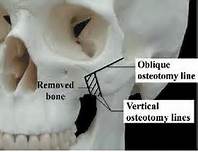
In the June 2016 issue of the Journal of Plastic Reconstructive and Aesthetic Surgery an article on this subject was published entitled ‘Reduction Malarplasty using a Zygomatic Arch-Lifting Technique’. A total of 54 patients underwent this type of cheekbone reduction surgery over an 18 month period.The reduction technique creates an L-shaped osteotomy of the zygomaticomaxillary junction through an intraoral approach. A prefabricated U-shaped microplate and screws was used for arch fixation in the lifted position. The follow-up period ranged from 6 to 18 months and the results were assessed by postoperative CT scans.
The results of this zygomatic arch lifting technique was one of general satisfaction with the aesthetic outcomes. There were no major complications such as buccal branch facial nerve injury or protracted trismus. (difficult with opening) Inadequate bony contact occurred in two patients due to unanticipated trauma with immediate reduction and fixation thereafter. Minor wound infections developed in three patients which resolved with antibiotics.
Regardless of the osteotomy pattern, techniques in cheekbone reduction must factor in how to stabilize the new position and resist the pull down forces of gravity and the masseter muscle. This requires a stable form of bone fixation which always consist of some form of plate and screws. The use of such rigid bone fixation overcomes the design of almost any form of osteotomy design. In this arch-lifting technique the zygomatic complex is elevated thus ensuring an adequate bone to bone contact allowing for predictable and accurate aesthetiuc outcomes.
Dr. Barry Eppley
Indianapolis, Indiana


